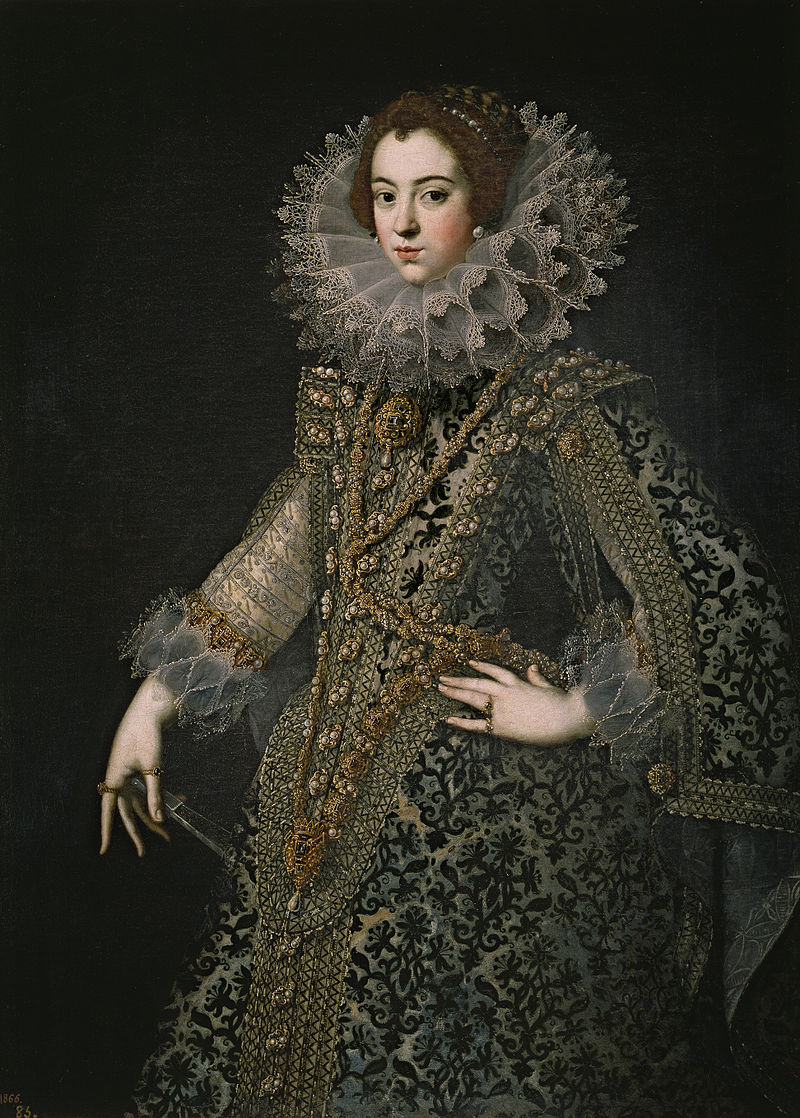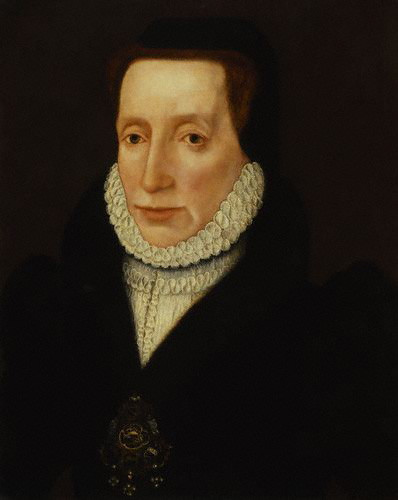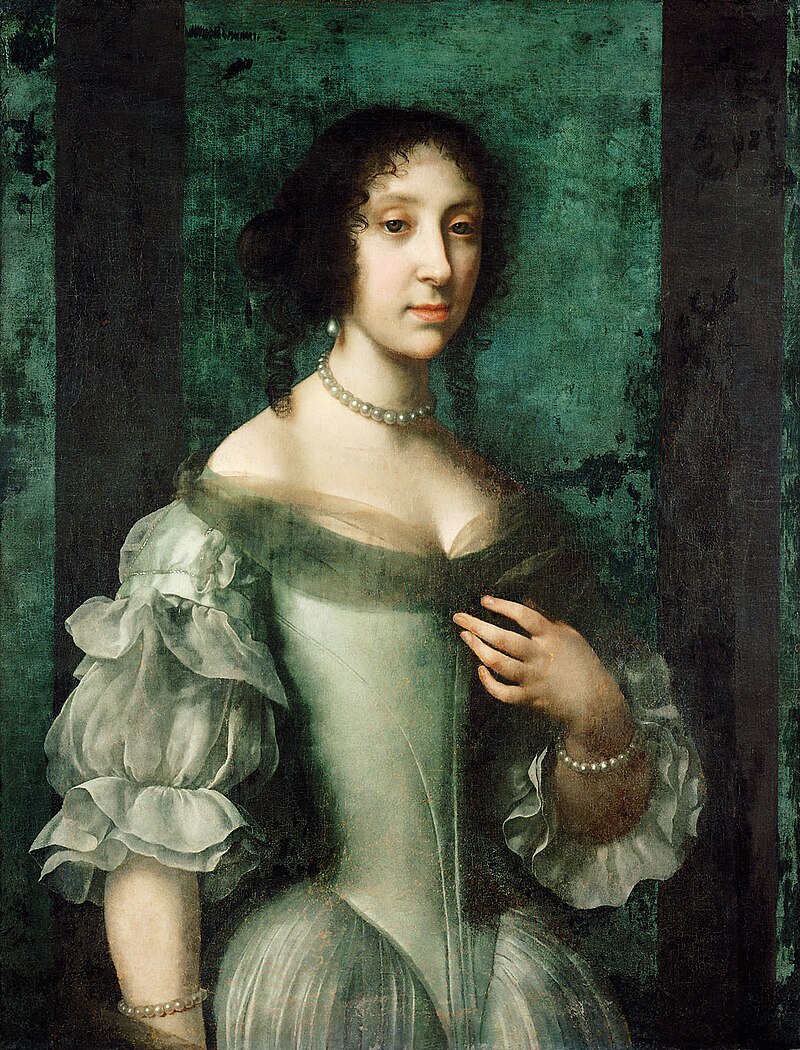© Unofficial Royalty 2023

Élisabeth of France, Queen of Spain and Portugal; Credit – Wikipedia
October 6, 1644 – Death of Élisabeth of France, Queen of Spain and Portugal, daughter of King Henri IV of France, first wife of King Felipe IV of Spain, at the Royal Alcázar in Madrid, Spain; buried at the Monastery of San Lorenzo El Real in El Escorial, Spain
In 1615, Elisabeth married the future King Felipe IV of Spain. Elisabeth and Felipe had eight children but only their youngest child, Maria Theresa of Austria, Infanta of Spain who married King Louis XIV of France, survived childhood. Besides having so many children die young, Elisabeth had three miscarriages. It is very probable that her husband transmitted a venereal disease he had contracted with one of his mistresses to Elisabeth. This would explain the miscarriages and the many dead infants. Weakened by her multiple pregnancies and miscarriages, Elisabeth died at the age of forty-one, after miscarrying a son.
Unofficial Royalty: Elisabeth of France, Queen of Spain and Portugal
October 6, 1773 – Birth of Louis-Philippe I, King of the French, at the Palais-Royal in Paris, France
At the onset of the French Revolution, Louis Philippe fled the country to avoid likely execution, which would be the fate of his father, and other members of the French royal family. In 1814, Napoleon Bonaparte, Emperor of the French was overthrown, and the Bourbons returned to the French throne. Louis Philippe returned to France and was welcomed into the French court during the reign of his cousins King Louis XVIII and King Charles X. In August 1830, King Charles X abdicated, naming his grandson, Henri, Duke of Bordeaux, as his successor. However, the Chamber of Deputies instead proclaimed Louis Philippe as the new monarch of France. An economic crisis of 1847, led to the French Revolution of 1848. Louis Philippe abdicated in favor of his grandson, Philippe, Count of Paris. Afraid that he may be imprisoned and executed, he quickly left Paris, and using a disguise, made his way to England. Two days later, the Second Republic was declared, once again ending the monarchy in France. In England, Louis Philippe and his wife took up residence at Claremont, a country house in Surrey, England, where they would live for the rest of their lives.
Unofficial Royalty: Louis-Philippe I, King of the French
October 6, 1779 – Birth of Francesco IV, Duke of Modena and Reggio at the Royal Palace of Milan in Milan, Duchy of Milan, now in Italy
Full name: Francesco Giuseppe Carlo Ambrogio Stanislao
Francesco was the son of Maria Beatrice d’Este, the heiress of Modena and Reggio and Archduke Ferdinand Karl of Austria, son of Francis Stephen, Duke of Lorraine, Grand Duke of Tuscany, Holy Roman Emperor and Maria Theresa, in her own right Archduchess of Austria, and Queen of Hungary, Croatia, and Bohemia. Francesco’s paternal grandfather Ercole III d’Este, Duke of Modena and Reggio had been deposed by Napoleon Bonaparte. Francesco regained the Duchy of Modena and Reggio as Francesco IV in 1814, after the fall of Napoleon. In 1812, 1812, 33-year-old Francesco married his 20-year-old niece Maria Beatrice of Savoy and they had four children. While Francesco’s grandfather Ercole III reigned the Duchy of Modena and Reggio as an enlightened monarch, Francesco’s reign was more autocratic.
Unofficial Royalty: Francesco IV, Duke of Modena and Reggio
October 6, 1808 – Birth of King Frederik VII of Denmark at Amalienborg Palace in Copenhagen, Denmark
Full name: Frederik Carl Christian
When Frederik was not even a year old, his mother Charlotte Frederica of Mecklenburg-Schwerin was accused of adultery, divorced, and banished from the Danish court. Frederik never saw her again. In 1828, Frederik married Vilhelmine Marie of Denmark, the younger of the two daughters of the reigning King of Denmark, Frederik VI. The marriage was childless and unhappy, mostly due to Frederik’s affairs and drinking. The couple separated in 1834 and divorced in 1837. Frederik married again in 1841 to Caroline Mariane of Mecklenburg-Strelitz. Once again, the marriage was childless and unhappy. In 1844, Caroline Mariane went to visit her parents and refused to return to Denmark. The couple divorced in 1846. In 1848, Frederik succeeded to the throne upon the death of his father. Two years later, he married his third wife Louise Rasmussen, a ballerina and stage actress. Frederik began a relationship with Louise during the 1840s. As this was a morganatic marriage, Louise was not Queen of Denmark. Instead, she was given the title Countess Danner. Frederik and Louise did not have any children.
Unofficial Royalty: King Frederik VII of Denmark
October 6, 1819 – Death of Carlo Emanuele IV, King of Sardinia at the Palazzo Colonna in Rome, Papal States, now in Italy; buried at the Church of Sant’Andrea al Quirinale in Rome
Carlo Emanuele IV abdicated the throne of Sardinia, was the Jacobite pretender to the thrones of England and Scotland, although he never claimed the title, and ended his life as a novice in the Society of Jesus (the Jesuits). Carlo Emanuele IV married Marie Clotilde of France, the sister of King Louis XVI of France, but they had no children. Carlo Emanuele IV succeeded to the throne of Sardinia upon the death of his father Vittorio Amedeo III in 1796. In 1798, the French occupied Turin, the capital of the Duchy of Savoy, and forced Carlo Emanuele to give up all his territories on the Italian mainland. He withdrew to the island of Sardinia in 1799. When Marie Clotilde died from typhoid fever in 1802, Carlo Emanuele was so upset by her death that he decided to abdicate. He left the throne of Sardinia to his brother who reigned as Vittorio Emanuele I. Carlo Emanuele settled in Rome and the nearby town of Frascati, both now in Italy. In 1815, he took simple vows in the Society of Jesus (the Jesuits). He was never ordained as a priest but lived as a novice until his death at the age of 68.
Unofficial Royalty: Carlo Emanuele IV, King of Sardinia and Duke of Savoy
Unofficial Royalty: The Jacobite Succession – Pretenders to the British Throne
October 6, 1828 – Death of Charlotte, Princess Royal, Queen of Württemberg, daughter of King George III of the United Kingdom and wife of King Frederick I of Württemberg, at Ludwigsburg Palace in Ludwigsburg, Kingdom of Württemberg, now in Baden-Württemberg, Germany; buried in the Royal Crypt in the Castle Chapel at Ludwigsburg Palace in Ludwigsburg
The living conditions of King George III’s six daughters came to be known as “the Nunnery.” None of the daughters were allowed to marry at the age when most princesses would marry. Charlotte was one of the three who eventually did marry. At the age of 31, Charlotte married 49-year-old Friedrich, Hereditary Prince of Württemberg, the future King of Württemberg. He was a widower with three children. His first wife had been Augusta of Brunswick-Wolfenbüttel, niece of King George III, and there were some issues with this marriage that concerned King George III. Only after persistent requests and pleadings from Russian and Brunswick royals and British officials did the king consent to the marriage. After Charlotte delivered a stillborn daughter, the marriage remained childless. Her husband Friedrich died of pneumonia in 1816. In 1827, Charlotte returned to England for the first time since her wedding in 1797, for the treatment of pulmonary edema, called dropsy at that time. She enjoyed returning to her home country and seeing her relatives, especially her eight-year-old goddaughter Princess Victoria, the future Queen Victoria. Soon after her return to Württemberg, Charlotte fell ill. Her spirits were lifted by visits from her brother Adolphus and her sister Elizabeth, but it was evident that she was dying. On October 5, 1828, Charlotte asked that her stepson King Wilhelm I of Württemberg and his family come to her bedside. The next day, Charlotte died peacefully in the arms of her stepson surrounded by his family, her friends, and her faithful servants.
Unofficial Royalty: Charlotte, Princess Royal, Queen of Württemberg
October 6, 1891 – Death of King Karl I of Württemberg in Stuttgart, Kingdom of Württemberg, now in Baden-Württemberg, Germany; in the crypt beneath the Schlosskirche at the Old Castle (Altes Schloss) in Stuttgart
In 1846, Karl married Grand Duchess Olga Nikolaevna of Russia, the daughter of Nicholas I, Emperor of All Russia. The marriage appeared to be a happy one, although it is possible it was never consummated. By most accounts, Karl was homosexual and enjoyed very close relationships with several men through the years. Karl and Olga adopted Olga’s niece, Grand Duchess Vera Konstantinovna. Karl became King of Württemberg upon his father’s death in 1864. He was far more liberal than his father, and this was reflected in his actions. He restored the freedom of the press and universal suffrage. Although he sided with Austria during the Austro-Prussian War of 1866, he soon entered into a treaty with Prussia, and would later fight alongside them in the Franco-Prussian War of 1870.
Unofficial Royalty: King Karl I of Württemberg
October 16, 1969 – Death of Princess Theodora of Greece and Denmark, Margravine of Baden, sister of Prince Philip, Duke of Edinburgh, in Büdingen in Hesse, Germany; buried in the Baden family cemetery in Salem, Germany
Raised primarily in Greece, Theodora and her family had to leave Greece several times due to the political unrest and repeated overthrow of the monarchy. They spent several years living in Switzerland and later settled outside of Paris. After her mother suffered a nervous breakdown in 1930, Theodora and her sisters were quickly married, all into former reigning German royal families. In 1931, Theodora married Berthold, Margrave of Baden, the son of Maximilian, Margrave of Baden and Princess Marie Luise of Hanover. The couple was second cousins through their mutual descent from King Christian IX of Denmark and they had three children. In her later years, Princess Theodora spent time with her children and grandchildren and made occasional visits to England to see her brother Philip and his family. She died at the age of 63, just five weeks before the death of her mother, born Princess Alice of Battenberg.
Unofficial Royalty: Princess Theodora of Greece and Denmark, Margravine of Baden
October 6, 2002 – Death of Prince Claus of the Netherlands, born Klaus-Georg von Amsberg, husband of Queen Beatrix of the Netherlands, at the AMC University Hospital in Amsterdam, the Netherlands; buried at the Nieuwe Kerk in Delft, the Netherlands
On New Year’s Eve in 1962, Claus met Princess Beatrix of the Netherlands, the heir to the Dutch throne, at a party with friends in Bad Driburg, Germany. The couple met again at the wedding eve party of Princess Tatjana of Sayn-Wittgenstein-Berleburg and Moritz, Landgrave of Hesse, in 1964. Prince Richard of Sayn-Wittgenstein-Berleburg acted as a go-between for the couple and did much to strengthen their relationship. Claus and Beatrix were married on March 10, 1966, at the Westerkerk, a large church In Amsterdam, the Netherlands, just down the street from the building where Dutch Jewish teenager Anne Frank hid during World War II. The couple had three sons. Claus suffered from various health issues. He was diagnosed with Parkinson’s disease in 1991. Claus underwent successful surgery for prostate cancer in 1998, but the radiation for the cancer caused urinary tract problems. In 2001, a kidney was removed and he had problems with the other kidney. Respiratory infections kept him in the hospital during the spring of 2002, shortly after the wedding of his eldest son Willem-Alexander. Two months before his death, he had a coronary angioplasty. Claus died at the age of 76 from Parkinson’s disease and pneumonia.
Unofficial Royalty: Prince Claus of the Netherlands
October 6, 2012 – Death of Albert, Margrave of Meissen, disputed Head of the House of Saxony and pretender to the former throne of the Kingdom of Saxony, in Munich, Germany; buried at the Old Catholic Cemetery in Dresden, Saxony, Germany
Full name: Albert Joseph Maria Franz-Xaver, Prince of Saxony
Albert, Margrave of Meissen was briefly one of the disputed Heads of the House of Saxony and pretender to the former throne of the Kingdom of Saxony.
Unofficial Royalty: Albert, Margrave of Meissen
This article is the intellectual property of Unofficial Royalty and is NOT TO BE COPIED, EDITED, OR POSTED IN ANY FORM ON ANOTHER WEBSITE under any circumstances. It is permissible to use a link that directs to Unofficial Royalty.














